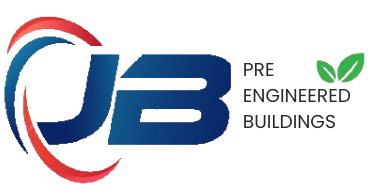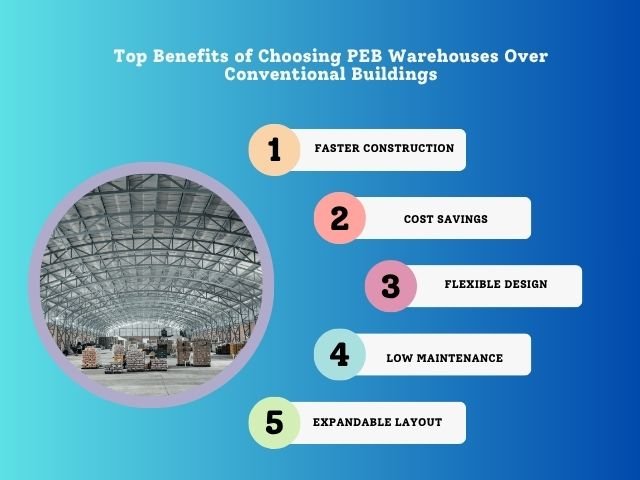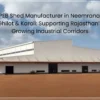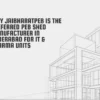Top Benefits of Choosing PEB Warehouses Over Conventional Buildings
Discover the top benefits of choosing PEB warehouses over conventional buildings, including cost savings, faster construction, and eco-friendly designs. Learn why pre-engineered buildings are revolutionizing modern warehousing.
Introduction: Why Choose a PEB Warehouse?
Imagine you’re planning a new warehouse for your growing business. You’re torn between a traditional brick-and-mortar building and something more modern. Then you hear about pre-engineered buildings (PEBs). What makes them so special? The top benefits of choosing PEB warehouses over conventional buildings include lower costs, faster construction, and incredible flexibility. In a world where efficiency and sustainability matter, PEB warehouses are transforming how businesses approach construction.
Warehouses are the backbone of industries like logistics, manufacturing, and e-commerce. Choosing the right building type can make or break your operations. PEB warehouses, designed with precision and pre-fabricated components, offer advantages that conventional buildings simply can’t match. Let’s dive into why PEBs are the smarter choice for modern businesses.
What Are PEB Warehouses?
Pre-engineered buildings (PEBs) are structures designed and manufactured off-site, then assembled on location. Unlike conventional buildings, which rely on traditional construction methods like concrete and masonry, PEBs use steel frames and modular components. This approach streamlines construction and delivers unmatched benefits.
The top benefits of choosing PEB warehouses over conventional buildings include their ability to meet specific business needs, from small storage units to massive distribution centers. PEBs are engineered for efficiency, making them a game-changer in the warehousing industry.
Cost Efficiency: Save Money Without Sacrificing Quality
One of the standout advantages of PEB warehouses is their cost-effectiveness. Traditional construction often involves unpredictable expenses—labor overruns, material waste, and lengthy timelines. PEBs, however, are designed to minimize these costs.
- Lower material costs: PEBs use optimized steel designs, reducing waste.
- Reduced labor expenses: Pre-fabricated components require less on-site work.
- Faster project completion: Shorter timelines mean lower financing costs.
For example, a 2023 study by the Metal Building Manufacturers Association found that PEBs can save up to 30% on construction costs compared to conventional buildings. This makes them ideal for businesses looking to maximize their budget.
Speed of Construction: Get Your Warehouse Up in Record Time
Time is money, especially in warehousing. PEB warehouses are built significantly faster than conventional buildings. Since components are pre-manufactured and delivered ready-to-assemble, construction timelines are slashed.
- Quick assembly: PEBs can be erected in weeks, not months.
- Minimal delays: Factory-controlled production avoids weather-related setbacks.
- Immediate usability: Warehouses are ready for operations sooner.
A logistics company in Texas reported completing a 50,000-square-foot PEB warehouse in just 12 weeks, compared to 6–8 months for a traditional build. The top benefits of choosing PEB warehouses over conventional buildings shine when speed is a priority.
Flexibility and Customization: Tailor-Made for Your Needs
PEB warehouses offer unmatched flexibility. Whether you need a small storage facility or a sprawling distribution hub, PEBs can be customized to fit your exact specifications.
- Scalable designs: Easily expand or modify your warehouse later.
- Custom layouts: Accommodate specific equipment or workflows.
- Aesthetic options: Choose finishes that align with your brand.
For instance, a retail chain in California used a PEB warehouse to create a hybrid storage and office space, tailored to their unique needs. This adaptability is a key reason why businesses prioritize PEBs over conventional buildings.
Durability and Strength: Built to Last
PEB warehouses are engineered for durability. Made from high-quality steel, they withstand harsh weather, seismic activity, and heavy loads better than many traditional structures.
- Corrosion-resistant materials: Steel is treated to prevent rust.
- High load capacity: Ideal for heavy equipment or stacked inventory.
- Long lifespan: PEBs often last 50+ years with minimal maintenance.
A manufacturing firm in Ohio chose a PEB warehouse to replace an aging concrete structure. After a decade, the PEB showed no significant wear, proving its long-term reliability.
Energy Efficiency: Lower Your Operating Costs
Energy costs are a major concern for warehouse operators. PEB warehouses are designed with energy efficiency in mind, helping businesses save money and reduce their environmental footprint.
- Insulated panels: Keep interiors cool in summer and warm in winter.
- Natural lighting options: Skylights reduce reliance on artificial lighting.
- Sustainable materials: Many PEBs use recycled steel.
According to the U.S. Department of Energy, PEB warehouses can reduce energy consumption by up to 20% compared to conventional buildings. This makes them a smart choice for eco-conscious businesses.
Eco-Friendly Construction: A Greener Choice
Sustainability is more than a buzzword—it’s a business imperative. PEB warehouses are inherently eco-friendly, offering benefits that align with green building standards.
- Less waste: Precision manufacturing minimizes material waste.
- Recyclable materials: Steel components are fully recyclable.
- Smaller carbon footprint: Faster construction reduces energy use.
A 2024 report by the World Green Building Council highlighted PEBs as a top choice for sustainable industrial construction. Choosing PEB warehouses over conventional buildings supports both your business and the planet.
Low Maintenance: Save Time and Money Long-Term
Conventional buildings often require frequent repairs—cracked concrete, leaking roofs, or structural wear. PEB warehouses, on the other hand, are low-maintenance by design.
- Durable coatings: Protect against rust and weathering.
- Modular repairs: Damaged sections can be replaced easily.
- Minimal upkeep: No need for constant repainting or sealing.
A distribution center in Florida reported saving $10,000 annually on maintenance after switching to a PEB warehouse. This cost-saving aspect is a key part of the top benefits of choosing PEB warehouses over conventional buildings.
Safety Features: Protect Your Assets and Workers
Safety is critical in any warehouse. PEBs are designed with advanced safety features to protect both your inventory and employees.
- Fire-resistant materials: Steel reduces fire risks compared to wood or concrete.
- Seismic stability: Engineered to withstand earthquakes.
- Clear-span designs: Eliminate columns, reducing workplace hazards.
A PEB warehouse in California passed strict seismic safety standards, giving the owner peace of mind during earthquake-prone seasons.
Versatility Across Industries: PEBs for Every Business
PEB warehouses aren’t just for logistics. Their Moderna warehouses have served industries from agriculture to aerospace.
- Agriculture: Store equipment or crops in durable, weather-resistant spaces.
- Manufacturing: House heavy machinery in clear-span warehouses.
- E-commerce: Optimize space for fast-paced inventory turnover.
A Midwest farmer used a PEB warehouse to store equipment and reported it was easier to maintain than his old wooden barn. This versatility makes PEBs a top choice across sectors.
Comparing Costs: PEB vs. Conventional Buildings
To highlight the top benefits of choosing PEB warehouses over conventional buildings, let’s break down the costs:
| Aspect | PEB Warehouse | Conventional Building |
|---|---|---|
| Construction Cost | 20–30% lower | Higher due to materials |
| Build Time | 6–12 weeks | 6–12 months |
| Maintenance | Low, minimal repairs | High, frequent repairs |
| Energy Efficiency | Up to 20% savings | Standard or lower |
This comparison shows why PEBs are often the more economical and practical choice.
Top Benefits of Choosing PEB Warehouses Over Conventional Buildings – Frequently Asked Questions
What are the main benefits of PEB warehouses?
PEB warehouses offer cost savings, faster construction, flexibility, and energy efficiency compared to conventional buildings. They’re durable, eco-friendly, and low-maintenance, making them ideal for modern businesses. Learn more about cost efficiency.
How much can I save with a PEB warehouse?
You can save up to 30% on construction costs and 20% on energy costs with a PEB warehouse, according to industry studies. See the cost comparison.
Are PEB warehouses durable?
Yes, PEB warehouses are made of high-quality steel, offering a lifespan of 50+ years and resistance to weather and seismic activity. Read about durability.
How fast can a PEB warehouse be built?
PEB warehouses can be constructed in 6–12 weeks, compared to 6–12 months for conventional buildings. Explore construction speed.
Are PEB warehouses eco-friendly?
Yes, PEBs use recyclable materials, produce less waste, and have a smaller carbon footprint. Learn more about sustainability.
Can PEB warehouses be customized?
Absolutely. PEBs offer scalable designs, custom layouts, and aesthetic options to suit any business. See customization options.
Are PEB warehouses safe?
PEBs feature fire-resistant materials, seismic stability, and clear-span designs for enhanced safety. Read about safety features.
Conclusion: Why PEB Warehouses Are the Future
The top benefits of choosing PEB warehouses over conventional buildings are clear: cost savings, speed, flexibility, durability, and sustainability make PEBs a superior choice for modern businesses. Whether you’re in logistics, manufacturing, or e-commerce, a PEB warehouse can streamline your operations and save you money. Ready to make the switch? Share your experience or check out our guides on warehouse design and sustainable construction.






